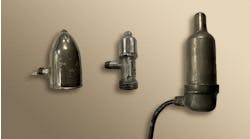Radiant heat replaces heat pump system that couldn't handle frigid northern winters
There's one thing many professionals in the HVAC industry usually agree on: in the northern reaches of the country, standard heat pumps are outmatched by cruel winter temperatures. The Hammer family of Manheim, Pa., fought back and, this time, Old Man Winter took a beatin.'
Two winters ago, Brian and Crystal Hammer and their two children began wearing sweatshirts in the house to stay warm inside. With outside temperatures hovering around 20°F for weeks on end, their heat pump couldn't push inside temperatures above 55°.
"If it got colder outside — down to 5°F or so, which it did for several days — we got colder, and the only thing we could do was to add more clothes during the day, and more blankets at night" said Brian Hammer.
It's another, even tougher source of discomfort, when the electricity bill arrives. The Hammer's monthly electric bills during the winter of ' 02-' 03 ranged between $200 and $300. By Thanksgiving and Christmas of 2003, indoor home temperatures were cooling holiday warmth considerably.
"We felt like we were throwing lots of money away, literally," said Brian. "The house wasn't warm, we were uncomfortable, and the utility bills kept getting higher and higher. We decided to fight back."
Following a friend's referral, the Hammers called on Dave Yates, president of F.W. Behler Inc., based in York, Pa. Yates tested the seven-year-old heat pump system ( installed when the home was built), studied the " envelope" — doors, windows and level of insulation — and asked lots of questions. He scrutinized the system's air handler and electric water heater too.
"I felt like a doctor delivering great news," said Yates when he'd completed the system check-up. "Although they needed 'major surgery,' the problem could be cured."
But like any good physician, Yates gave them some options. He explained that he could beef-up the "toaster" in the heat pump air handler; this would be the cheapest fix, but the most expensive to operate. He could install an oil or gas furnace, saving the heat pump for its air-conditioning function in the summer. Or, he could provide them with a system that would give them the best comfort and operating economy.
Though the Hammers admitted to a fairly tight budget, they also spoke of their interest in radiant heat.
"It was like they'd read my mind," marveled Yates.
Yates responded by offering a solution the homeowners readily chose to go with. They settled on a plan to install a small, high-efficiency boiler, retain the heat pump for summer duty, and add a hydronic coil that would provide warmth for the second floor. He would also install a two-zone, eightloop staple-up radiant system heat for the entire first floor.
Two temperature zones were required because of the dissimilarity of the floor coverings on the first floor, which includes hardwood, vinyl and wall-to-wall carpet. By using Watts Radiant's system design software, the varying floor supply water temperatures were quickly matched with manifolds, loop lengths and flow rates.
Simpler-is-better control panel
The system that Yates designed would call for multiple temperatures from a single source. Rather than putting lots of hours into building a control panel, Yates told Watts the components and function of a control panel they would build, timed for arrival with the other ordered materials.
"The Hammers had set a fairly tight budget for the project, so I settled on a simple mixing strategy," said Yates. "A simpler-is-better approach not only saves money on the front end by reducing installation and material costs ... electrical costs are minimized, too. This is often ignored when systems are designed.
"A primary loop drives the heated water past two detours on the Btu highway," Yates said. "If a heating cycle is activated, Btus are diverted to a threeway mixing valve, which then tempers the water as needed."
Tiny sabers hanging down
About 1,200 lineal feet of Watts EPDM tubing was ordered for the home's staple-up radiant system, chosen because of the several advantages it offered.
"We like the material because of its excellent heat transfer when stapled-up," said Yates. "The tubing, by design, is slightly flattened against the underfloor when stapled into position. This greatly increases the surface area for contact with subfloor, moving heat out of the tubing and into the floor, without metal plates. Its rope-like flexibility gives it two other key advantages for a job like this. It's easy to install, so we spend a lot less time on the installation, unlike PEX, which has a mind of its own. And, most important for this job, this was the only tubing we could use to weave between the thousands of protruding metal nails driven through the subfloor when the home's hardwood flooring was applied."
According to Yates, had they used a less flexible radiant tubing, most of the flooring nails would have been removed, a time-consuming and costly process.
"We've tried snipping them off in the past, but that still leaves behind a sharp little stub which is still a threat to the tubing and clearly prevents good contact between the tubing, or metal plates, if they're used. This puts a stop to good thermal transfer, defeating the whole purpose."
Yates explained that they learned about flooring nails the hard way. A few years ago, his firm undertook a PEX staple-up job under a large great room with hardwood flooring.
"We knew we were in for a rough time!" exclaimed Yates. "The joist bays [had] oodles of sharp staple-nails hanging down like tiny sabers."
The boiler that Yates installed is a fully modulating, sealed combustion, 85+% AFUE LP gas Endurance boiler/water heater made by Laars. Its internal bypass, pump, heat exchanger and 20-gal. stainless steel storage tank matched it nicely to the Hammer's needs.
"We wanted to get the domestic water capability because their buildergrade electric water heater wasn't saving them any money, either," said Yates. "An all-in-one package really appealed to the homeowners. We were glad to disconnect the old one."
The new system automatically adjusts to the home's varied needs and heat demand, from 57% draw to fullfire (or, from 61,800 Btuh to 108,200 Btuh). The unit's built-in microprocessor monitors boiler, tank and flow temperatures and has a diagnostic display to simplify servicing. The boiler also has a hot surface ignition system, builtin freeze protection, a pump exerciser to keep the pump corrosion-free, and an overheat thermostat.
(Gas is supplied by a 500-gallon LP tank installed by the local supplier. Brian Hammer decided place the tank next to a new garden shed 40 ft. from the house, then trenched a line to a point of entry at the far end of the basement. Yates used corrugated stainless steel tubing to supply the boiler.)
"We're now free to invite guests over during the winter months," said Crystal Hammer. "That's something we simply weren't comfortable with before. Another thing we like is the unlimited hot water for showers. Before the new system was installed, we were limited to just two short showers, with a long wait in-between for the water heater to heat up again. Then, two more. We don't 'take numbers' any more."
"After several winters in our home where we just endured the cold, it's hard to describe the comfort we have today," said Brian Hammer. "We used to scan the newspaper anxiously for winter temperatures. When cold temperatures were predicted, that meant we'd be cold inside — sometimes really cold. Then we worried about the utility bill. It was like a cycle of worry. It was awful. Today, we have such a sense of peace about the home and being in it. The weather page is the last page we turn to, not the first. And we enjoy warmth in the home, not discomfort."
In January 2004, the Hammers saved more than $100 when paying their first utility bill with the new system in place, and that was just for the last 18 days of the month. For February, the savings were more than $200.
Recently, the electric utility audited electric use at their house. The Hammers, who pay electric on a budget plan that averages monthly costs, were pleasantly surprised to see their monthly budget amount drop from $161/month to $78/month.
"Substantial savings with no compromise to comfort," said Brian Hammer. "We can live with that."

